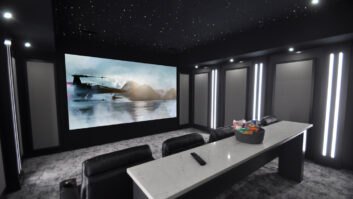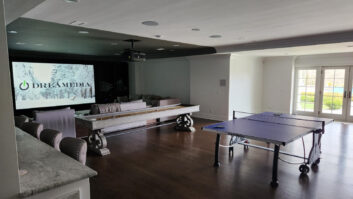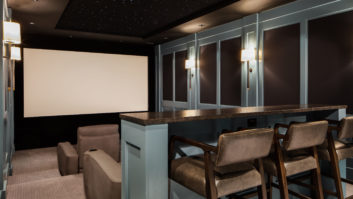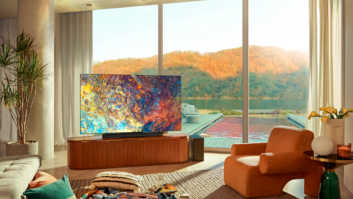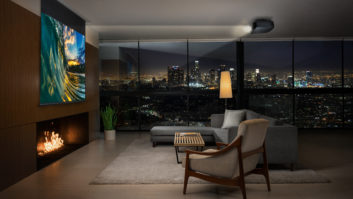Matte white projection screens have been the reliable stand-by in home theaters for years. They easily accommodate a large viewing group, and there was little need for improvement until the darkness of the dedicated theater room gave way to well lit recreation and living rooms.
Fierce industry competition has served consumers well over the last 10 years by producing extraordinary quality projectors at unbelievably low costs. The results have made a quality home theater projector and screen affordable to even a modest budget. When the projection screen became a common household fixture, the next step was to replace the flat-panel TV with a larger-than-life projected image.
The problem with using a matte white projector screen in a “TV” environment is that the image gets washed out by ambient light. Ambient light rejecting (ALR) projector screen materials were the obvious answer. They enhance the visual qualities of a projected image while preventing the milky glare of ambient light from spoiling the picture. What started as a “must have” for the select few who could afford it has become an industry norm for everyone interested in “bringing home the big screen.”
As an industry technology writer, I like ALR screens more than I like matte white entirely because of the technology that went into developing such a complicated, yet simple, material. That said, the soft spot that I have for consumers compels me to hate it when they are oversold on an installation where a matte white screen would have served the customer just fine. So which is best for your application? The versatility of matte white versus the precision excellence of ALR projector screens — the choice is ultimately yours but here are some points to help you with your decision.
What’s the Difference Between Matte White and ALR?
Matte white is still the most common type of projector screen on the market today. It typically has a 1.0-1.2 gain classification. Gain is the measure of a projector screen’s ability to make a projected image brighter/duller. Matte white screens make up the neutral medium of gain that is around ±1.0 gain. Magnesium carbonate (MgCO3) is the often-accepted control point of 1.0 gain against which the brightness of projector screens is typically compared. Because it is the measured point of dynamic range that comes the closest to “pure white,” magnesium carbonate is typically an essential ingredient in the manufacture of matte white projector screens, as well.
The advantages of matte white screen materials are versatility and cost. Matte white screen materials are versatile because of their wide diffusion uniformity, which means that an equal amount of brightness will be reflected into a viewer’s field of vision regardless of how far centered or off axis their viewing angle is. (Figure 1) Due to the low cost and ease of construction, matte white projection screens are much cheaper to make. Because of this, matte white projector screens are preferred as long as there is a control over ambient light in your projection environment. They are also compatible with standard, short-throw, or ultra short-throw projectors when offered in a tensioned format.

Figure 1: Illustration of a centered projector placement vs. off axis
The disadvantages of matte white projection screens are that they are easily washed out by ambient light and they do little to enhance image brightness and/or contrast. Ambient light is essentially all the light in your projection environment that is not coming from your projector. Because matte white screens do so well at uniform diffusion, they will also reflect ambient light causing your reflected screen image to be washed out. In addition to this, matte white is neutral, so it does little to enhance contrast with either the dynamic range of black levels or color. Any necessary enhancements to color temperature, saturation or black levels are left entirely up to the projector and its installer’s ability to calibrate it properly.
Ambient Light Rejecting (ALR) materials can filter out ambient light to provide and even surpass “TV panel” brightness regardless if the lights are on or off. They typically consist of a highly reflective base layer topped with a series of diffusion layers that filter out off-axis lighting. ALR materials also serve a dual role of enhancing the picture’s dynamic range so that the image may be brighter, colors more vibrant, and black levels more defined. In the case of angular reflective ALR screens, the reflective base compresses the brightness into a narrower “half-gain cone,” which in turn enhances the picture’s luminescence. Its outer diffusion layer gives the screen material a gray appearance. The ALR screen appears gray to our eyes because it is filtering out the ambient light from the room. Because a white screen doesn’t filter out ambient light, we see it as a white projection surface. The ALR screen filters most of that light out, leaving us with a gray projection surface to look at. This is why these ALR projector screens are commonly referred to as “Grey,” “Dark,” or “Black” screens.
Characteristics of Retro and Angular ALR Screens
Angular reflective means that light reflects off the surface at precisely the opposite angle of incidence exactly as the laws of reflection describe and as Figure 2 illustrates.

Figure 2: How an angular reflective (ALR) screen works
This type of screen gives favorable results in either residential or commercial applications. The material prevents full diffusion from occurring to provide greater control over the washout effects of ambient light.
“Retro reflective” means that the projected light reflects back directly toward the projection source at the same angle of incidence (see Figure 3.) The material typically requires a reflective base comprised of serriform micro structures that channels back only the light from the projector source.

Figure 3: Illustration of how a retro reflective ALR screen works
Because of its ability to provide stunning brightness and picture quality but with limited flexibility on projector placement, retro reflective ALR is the preferred format in high performance home theater applications.
How to Properly Use an ALR Projection Screen
Be sure that the projector is properly centered (as seen in Figure 1) in either a ceiling mount or tabletop installation. Make sure that ambient light sources such as floodlights or windows present light from behind the projector onto the screen. The one way that ambient light can defeat an ALR material is if it is hitting the screen at the same angle of incidence as the projector’s light. Ambient light coming from the same direction as the projector will appear on the screen the same way the projected image does.
Another Option, the Ceiling Light Rejecting (CLR)
Ultra short throw (UST) projectors are rapidly gaining ground in this market. UST projectors present the advantage of being so close to the screen material that it’s impossible for someone to walk between the projector and screen (the biggest pet peeve of projection systems). Because UST projectors spread out their light signal from an off-axis angle of incidence, they won’t work with a regular ALR material. In addition to filtering horizontally off axis light, CLR material rejects up to 95 percent of overhead light as well. They use an angular serriform microstructures to present what is commonly mistaken as a +100-120-inch flat-panel display at a small fraction of the cost one would pay to actually have a 100-inch flat panel installed in their home. This opens the channel for integrators to access a customer base that was previously priced out of the market.
In a Nutshell
ALR screens vastly outstrip the performance of matte white screens with superior brightness while filtering out ambient light. The end result is that is creates a realistic high-resolution image to be appreciated in all its glory with the lights on or off. Color is more vivid and high resolution (UHD and 4K) content is more defined. A quality video presentation is as sensual an experience as fine wine or a gourmet meal. So indulge your eyes to the best in high-end visual performance. After all, why should your taste buds have all the fun?
Dave Rodgers, marketing manager for Elite Screens Inc. has more than 20 years of experience in the AV and wireless communications industries.
